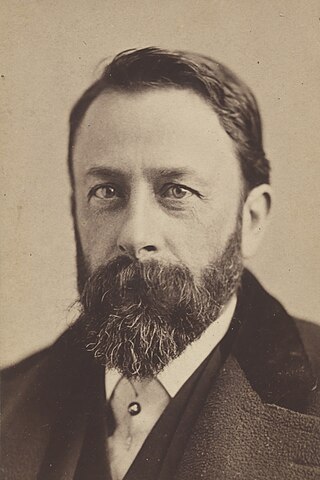
Albert Bierstadt was a German American painter best known for his lavish, sweeping landscapes of the American West. He joined several journeys of the Westward Expansion to paint the scenes. He was not the first artist to record the sites, but he was the foremost painter of them for the remainder of the 19th century.

Winslow Homer was an American landscape painter and illustrator, best known for his marine subjects. He is considered one of the foremost painters of 19th-century America and a preeminent figure in American art in general.

Willem van de Velde the Younger was a Dutch marine painter, the son of Willem van de Velde the Elder, who also specialised in maritime art. His brother, Adriaen van de Velde, was a landscape painter.

Eugène Louis Boudin was one of the first French landscape painters to paint outdoors. Boudin was a marine painter, and expert in the rendering of all that goes upon the sea and along its shores. His pastels, summary and economic, garnered the splendid eulogy of Baudelaire; and Corot called him the "King of the skies".

The Gulf Stream is an 1899 oil painting by the American artist Winslow Homer. It shows a man in a small dismasted rudderless fishing boat struggling against the storm-tossed waves and perils of the sea, presumably near the Gulf Stream, and was the artist's statement on a theme that had interested him for more than a decade. During the time he explored this theme, Homer, a New Englander, boated often near Florida, Cuba, and the Caribbean.
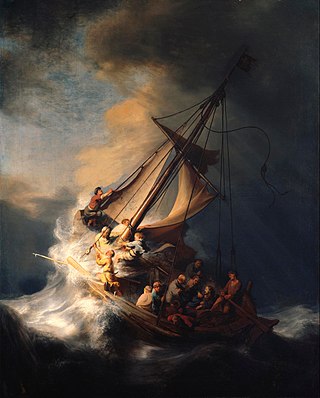
Marine art or maritime art is a form of figurative art that portrays or draws its main inspiration from the sea. Maritime painting is a genre that depicts ships and the sea—a genre particularly strong from the 17th to 19th centuries. In practice the term often covers art showing shipping on rivers and estuaries, beach scenes and all art showing boats, without any rigid distinction – for practical reasons subjects that can be drawn or painted from dry land in fact feature strongly in the genre. Strictly speaking "maritime art" should always include some element of human seafaring, whereas "marine art" would also include pure seascapes with no human element, though this distinction may not be observed in practice.

Christ in the Storm on the Sea of Galilee is a 1633 oil-on-canvas painting by the Dutch Golden Age painter Rembrandt van Rijn. It is classified as a history painting and is among the largest and earliest of Rembrandt's works. It was purchased by Bernard Berenson for Isabella Stewart Gardner in 1869 and was displayed at the Isabella Stewart Gardner Museum in Boston before its theft in 1990; it remains missing. The painting depicts the biblical event in which Jesus calmed the storm on the Sea of Galilee, as is described in the fourth chapter of the Gospel of Mark. It is Rembrandt's only seascape.
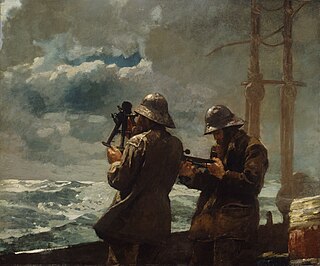
Eight Bells is an 1886 oil painting by the American artist Winslow Homer. It depicts two sailors determining their ship's latitude. It is one of Homer's best-known paintings and the last of his major paintings of the 1880s that dramatically chronicle man's relationship to the ocean.

Abraham Jacob Bogdanove was an American artist, mural painter, and teacher best known for his seascape paintings of the Maine coast, particularly around Monhegan Island.
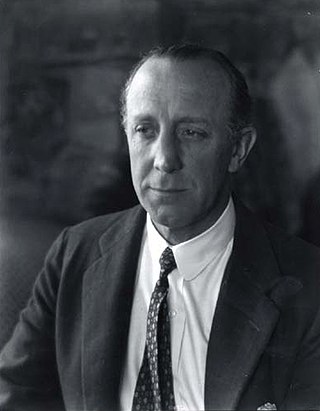
Paul Hampden Dougherty was an American marine painter. Dougherty was recognized for his American Impressionism paintings of the coasts of Maine and Cornwall in the years after the turn of the 20th century. His work has been described as bold and masculine, and he was best known for his many paintings of breakers crashing against rocky coasts and mountain landscapes. Dougherty also painted still lifes, created prints and sculpted.

Breezing Up (A Fair Wind) is an oil painting by American artist Winslow Homer. It depicts a catboat called the Gloucester chopping through that city's harbor under "a fair wind" (Homer's original title). Inside the boat are a man, three boys, and their catch.

The Boat Builders is an oil painting on panel executed in 1873 by American landscape painter Winslow Homer. It is held in the collection of the Indianapolis Museum of Art (IMA), in Indianapolis, Indiana, United States.

The Fog Warning is one of several paintings on marine subjects by the late-19th-century American painter Winslow Homer (1836–1910). Together with The Herring Net and Breezing Up, painted the same year and also depicting the hard lives of fishermen in Maine, it is considered among his best works on such topics.
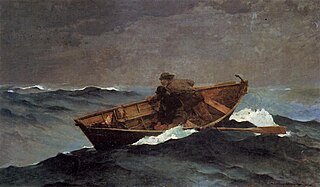
Lost on the Grand Banks (1885) is one of several paintings on marine subjects by the American painter Winslow Homer (1836–1910). Together with The Herring Net and The Fog Warning, painted in the same year, it depicts the hard lives of North Atlantic fishermen in Prouts Neck, Maine. The painting was bought in 1998 by Bill Gates, then-chairman of Microsoft, who reportedly paid $30 million for the seascape, at the time a record price for an American painting.

Cannon Rock is an 1895 oil painting by the American artist Winslow Homer. It is part of the Metropolitan Museum of Art's collection.

The Town is a 1903 oil painting by August Strindberg. It is shown at the Nationalmuseum in Stockholm.

Maine Coast is an 1896 oil painting on canvas by American artist Winslow Homer. It is part of the collection of the Metropolitan Museum of Art in New York.
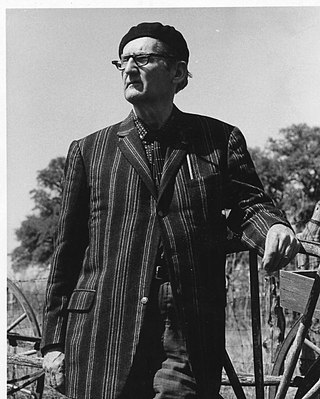
Arthur William Wilson was an American artist who painted under several known pseudonyms, including Winslow Wilson and Pico Miran. In Gloucester, Wilson/Miran has been considered an early actor in the Post Modern Art Movement. He is widely quoted from his Manifesto For Post-Modern Art, published in 1951, under the name Pico Miran.

Moonlight, Wood Island Light is a late 19th-century oil painting by American artist Winslow Homer. The painting is in the collection of the Metropolitan Museum of Art in New York.

Ground Swell is a 1939 painting by American artist Edward Hopper which depicts five people on a heeling catboat in a light swell, looking at an ominous buoy. It was in the collection of the Corcoran Gallery of Art from 1943 until it was purchased by the National Gallery of Art in Washington, D.C. in 2014.



















